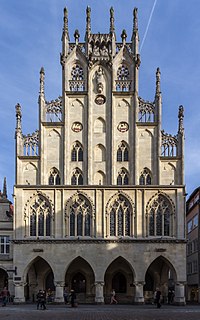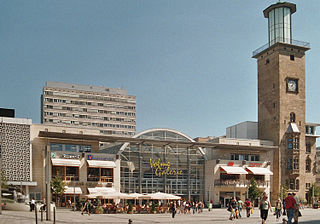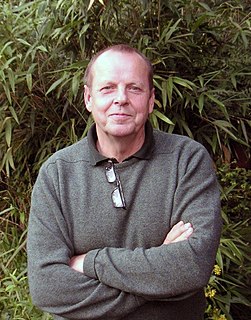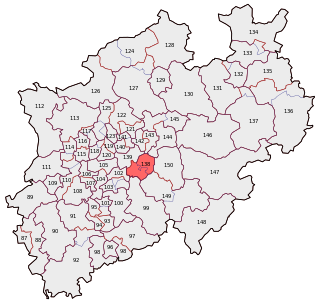
The Peace of Westphalia is the collective name for two peace treaties signed in October 1648 in the Westphalian cities of Osnabrück and Münster. They ended the Thirty Years' War (1618–1648) and Eighty Years' War (1568–1648), and brought peace to the Holy Roman Empire, closing a calamitous period of European history that killed approximately eight million people. The Holy Roman Emperor, the Spanish Monarchy, the kingdoms of France and Sweden, the United Provinces (Netherlands), and their respective allies among the princes of the Holy Roman Empire participated in these treaties.

Westphalia is a region of northwestern Germany and one of the three historic parts of the state of North Rhine-Westphalia. It has an area of 20,210 square kilometres (7,800 sq mi) and 7.9 million inhabitants.

North Rhine-Westphalia, commonly shortened to NRW, is a German state (Land) in Western Germany. With more than 17.9 million inhabitants, it is the most populous state of Germany. Apart from the city-states, it is also the most densely populated state in Germany. Covering an area of 34,084 square kilometres (13,160 sq mi), it is the fourth-largest German state by size.

The Ruhr, also referred to as Ruhr area, Ruhr district, Ruhr region, or Ruhr valley, is a polycentric urban area in North Rhine-Westphalia, Germany. With a population density of 2,800/km2 and a population of over 5 million (2017), it is the largest urban area in Germany. It consists of several large cities bordered by the rivers Ruhr to the south, Rhine to the west, and Lippe to the north. In the southwest it borders the Bergisches Land. It is considered part of the larger Rhine-Ruhr metropolitan region of more than 10 million people, which is among the largest in Europe.

Dortmund is the third-largest city in North Rhine-Westphalia after Cologne and Düsseldorf, and the eighth-largest city of Germany, with a population of 588,250 inhabitants as of 2021. It is the largest city of the Ruhr, Germany's largest urban area with some 5.1 million inhabitants, as well as the largest city of Westphalia. On the Emscher and Ruhr rivers, it lies in the Rhine-Ruhr Metropolitan Region and is considered the administrative, commercial, and cultural center of the eastern Ruhr. Dortmund is the second-largest city in the Low German dialect area after Hamburg.

Hagen is the 41st-largest city in Germany. The municipality is located in the state of North Rhine-Westphalia. It is located on the south eastern edge of the Ruhr area, 15 km south of Dortmund, where the rivers Lenne and Volme meet the river Ruhr. As of 31 December 2010, the population was 188,529.
The Ennepe-Ruhr-Kreis is a district in the center of North Rhine-Westphalia, Germany. It is part of the southern Ruhr urban area and has ca. 324,000 inhabitants (2012). The district's seat is Schwelm; the largest of its nine towns is Witten.

Soest is a city in North Rhine-Westphalia, Germany. It is the capital of the Soest district.

The Bergisches Land is a low mountain range region within the state of North Rhine-Westphalia, Germany, east of Rhine river, south of the Ruhr. The landscape is shaped by woods, meadows, rivers and creeks and contains over 20 artificial lakes. Wuppertal is one of the biggest towns and seen as the region's capital, whereas the southern part nowadays has closer economic and socio-cultural ties to Cologne. Wuppertal and the neighbouring cities of Remscheid, Solingen form the Bergisches Städtedreieck.

The Rhine-Ruhr metropolitan region is the largest metropolitan region in Germany, with over ten million inhabitants. A polycentric conurbation with several major urban concentrations, the region covers an area of 7,268 square kilometres (2,806 sq mi), entirely within the federal state of North Rhine-Westphalia. The Rhine-Ruhr metropolitan region spreads from the Ruhr area (Dortmund-Essen-Duisburg-Bochum) in the north to the urban areas of the cities of Mönchengladbach, Düsseldorf, Wuppertal, Leverkusen, Cologne, and Bonn in the south. The location of the Rhine-Ruhr at the heart of the European Blue Banana makes it well connected to other major European cities and metropolitan areas such as the Randstad, the Flemish Diamond and the Frankfurt Rhine Main Region.

The Volme is a river in North Rhine-Westphalia, Germany, and is a tributary of the river Ruhr. It is 50.5 kilometres (31.4 mi) long, of which about 21 km (13 mi) lie within the city limits of Hagen. Its largest tributary is the Ennepe.

Schwelm is a town in the district of Ennepe-Ruhr-Kreis in the administrative region of Arnsberg within the state of North Rhine-Westphalia.

The Hagen Westphalian Open-Air Museum is a museum at Hagen in the southeastern Ruhr area, North Rhine-Westphalia, Germany.

Dortmund Hauptbahnhof is the main railway station in Dortmund, North Rhine-Westphalia, Germany. The station's origins lie in a joint station of the Köln-Mindener Eisenbahn and Bergisch-Märkische Eisenbahn which was built north of the city centre in 1847. That station was replaced by a new station, erected in 1910 at the current site. It featured raised embankments to allow a better flow of traffic. At the time of its opening, it was one of the largest stations in Germany. It was, however, destroyed in an Allied air raid on 6 October 1944.

Eva Gronbach is a German fashion designer.
Duisburg: Town and Harbour is the Theme Route No. 1 of the Industrial Heritage Trail, which passes through Duisburg, the Inner Harbour, Ruhrort, the Duisburg-Ruhrorter harbour and other attractions on the Rhine and Ruhr. These trails were first developed between 1989 and 1999.

The Detmold Open-air Museum is a museum at Detmold in the Ostwestfalen-Lippe region of North Rhine-Westphalia, Germany. It was founded, together with the Hagen Open-air Museum, in 1960, and was first opened to the public in the early 1970s. The museum is run by the Landschaftsverband Westfalen-Lippe.

Peter Schwickerath is a German sculptor.

The Gau Westphalia-South was an administrative division of Nazi Germany encompassing the Arnsberg Region in the southern part of the Prussian province of Westphalia between 1933 and 1945. From 1931 to 1933, it was the regional subdivision of the Nazi Party for these areas.

Hagen – Ennepe-Ruhr-Kreis I is an electoral constituency represented in the Bundestag. It elects one member via first-past-the-post voting. Under the current constituency numbering system, it is designated as constituency 138. It is located in the Ruhr region of North Rhine-Westphalia, comprising the city of Hagen and the southern part of the Ennepe-Ruhr-Kreis district.


















